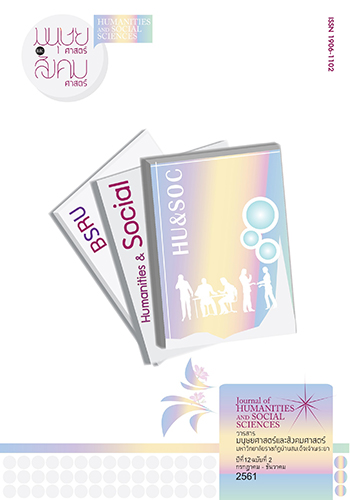Application of Legendary in Contemporary Thai Society: A Case Study of “Phuttha Nakorn Tham Group” Lampoon Province
Keywords:
Identity, Myth, Creative FolkloreAbstract
The paper studies applying legendary to the present context by using “Phuttha Nakorn Tham Group” in Lampoon province (“คณะพุทธนครธรรม” จังหวัดลำพูน) as a case study. The study indicates that “Phuttha Nakorn Tham Group” in Lampoon province applied the content from Queen Camadevi legendary and also introduced new media of presenting the story of Queen Camadevi. The group created a new set of thought concerning Queen Camadevi by constructing new content for historical memory of the Queen. In addition, based on the newly created historical story of the Queen, the Phuttha Nakorn Tham Group also built religious objects and religious places. This makes the Phuttha Nakorn Tham’s version of Camadevi story more convincing and reliable. Moreover, the group also deliberately created the image of “Faith in Buddhism,” in this way also creating the identity of the group to be different than other groups. Interestingly, based on the new version of the Queen’s story, the group also created various religious products with the branding of “Phuttha Nakorn Tham.” Overall, it can be perceived that the Phuttha Nakorn Tham Phra Nang Chao Camadevi Group uses the strategy of applying Queen Camadevi legend in order to insert their religious identity and their social space in contemporary Thai society. If viewed this phenomenon through the framework of “creative folklore,” we can see how folk belief, legend and local history has been applied, re-interpreted and given new meaning in the socio-religious context in the Thailand present day.
References
แก้ว อัมรินทร์. (2554). เกร็ดพระราชประวัติพระนางจามเทวี. กรุงเทพฯ : โอเชี่ยนบุคมาร์ท.
แก้ว อัมรินทร์. (2556). เกร็ดพระราชประวัติพระนางจามเทวี ภาค 2. กรุงเทพฯ : คอมม่าดีไซน์แอนด์พริ้นท์.
นิธิ เอียวศรีวงศ์. (2537, สิงหาคม). ลัทธิพิธีเจ้าแม่กวนอิม. ว.ศิลปวัฒนธรรม. 15(10), 78-106.
พระพุทธพุกามและพระพุทธญาณ. (2519). ตำนานมูลศาสนา. กรุงเทพฯ : เสริมวิทย์บรรณาคาร.
พระโพธิรังสี. (2554). จามเทวีวงศ์ พงศาวดารเมืองหริภุญไชย. กรุงเทพฯ : ศรีปัญญา.
พิเชฐ สายพันธ์. (2539). นาคาคติ อีสานลุ่มน้ำโขง: ชีวิตทางวัฒนธรรมจากพิธีกรรมร่วมสมัย. วิทยานิพนธ์สังคมวิทยาและมานุษยวิทยามหาบัณฑิต สาขาวิชามานุษยวิทยา คณะสังคมวิทยา มหาวิทยาลัยธรรมศาสตร์.
รัตนปัญญาเถระ. (2510). ชินกาลมาลีปกรณ์. แสง มนวิทูร, ผู้แปล. พระนคร : มิตนราการพิมพ์.
วริศรา อนันตโท. (2559). ภาพซีดีรวมพระโอวาทธรรมของพระนางจามเทวี. กรุงเทพฯ : มหาวิทยาลัยหอการค้าไทย.
วริศรา อนันตโท. (2559). ภาพเสื้อพระนางจามเทวีของคณะพุทธนครธรรมจำหน่ายเพื่อใส่ในการเข้าร่วมกิจกรรมกลุ่ม. กรุงเทพฯ : มหาวิทยาลัยหอการค้าไทย.
วริศรา อนันตโท. (2559). ภาพรูปเคารพเจ้าแม่กวนอิมและพระนางจามเทวีเคียงคู่กันและพระแก้วขาวเสตังคมณี ที่วัดศรีบุญเรือง จังหวัดลำพูน. กรุงเทพฯ : มหาวิทยาลัยหอการค้าไทย.
ศิราพร ณ ถลาง. (2552). ทฤษฎีคติชนวิทยา วิธีวิทยาในการวิเคราะห์ตำนานนิทานพื้นบ้าน. (พิมพ์ครั้งที่ 2). โครงการเผยแพร่ผลงานวิชาการ คณะอักษรศาสตร์ จุฬาลงกรณ์มหาวิทยาลัย.
ศิราพร ณ ถลาง. (2558). เรื่องเล่าพื้นบ้านไทยในโลกที่เปลี่ยนแปลง. กรุงเทพฯ : ศูนย์มานุษยวิทยาสิรินธร (องค์การมหาชน).
ศิราพร ณ ถลาง. (2559). คติชนสร้างสรรค์ : บทสังเคราะห์และทฤษฎี. กรุงเทพฯ : ศูนย์มานุษยวิทยาสิรินธร (องค์การมหาชน).
ศิริพร ภักดีผาสุข. (2561). ความสัมพันธ์ระหว่างภาษากับอัตลักษณ์และแนวทางการนำมาศึกษาภาษาไทย. กรุงเทพฯ : โครงการเผยแพร่ผลงานวิชาการ คณะอักษรศาสตร์ จุฬาลงกรณ์มหาวิทยาลัย.
สุจิตต์ วงษ์เทศ. (2559). นางนาค. ใน พลังผู้หญิง แม่เมีย และเทพสตรี : ความจริง และภาพแทน. กรุงเทพฯ : สำนักงานคณะกรรมการการศึกษาขั้นพื้นฐาน กระทรวงศึกษาธิการ.
สุชีพ ปุญยานุภาพ. (2511). ประวัติศาสตร์ศาสนา. พระนคร : โรงพิมพ์บำรุงสาส์น.
อานันท์ กาญจนพันธุ์. (2527). พัฒนาการชีวิตและวัฒนธรรมล้านนา. เชียงใหม่ : ศูนย์หนังสือมหาวิทยาลัยเชียงใหม่.
Downloads
Published
How to Cite
Issue
Section
License

This work is licensed under a Creative Commons Attribution-NonCommercial-NoDerivatives 4.0 International License.



